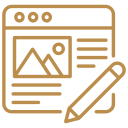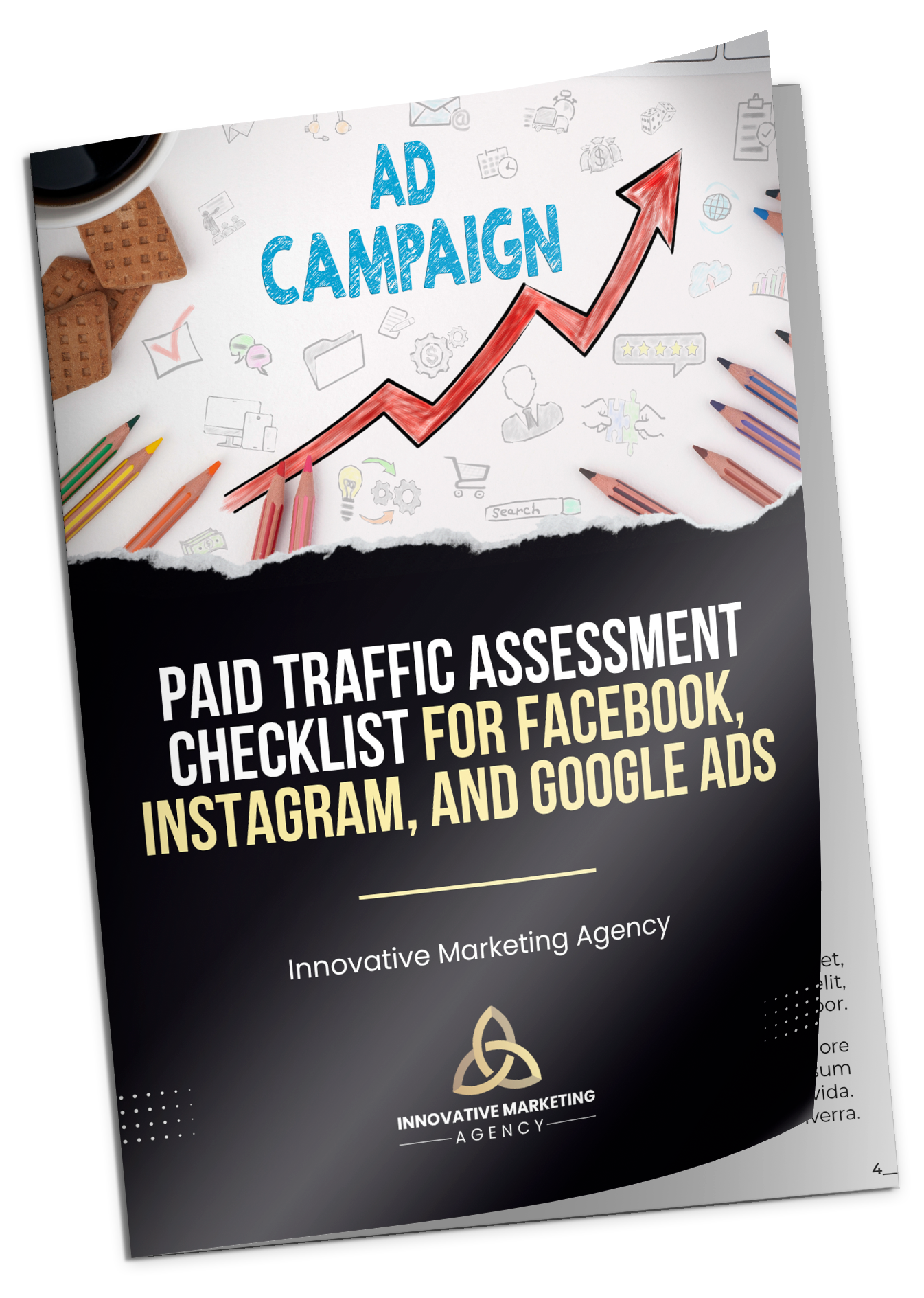Watch The Journey
BLOG
How to Maximize ROI from Paid Ads on Facebook, Instagram, and Google Ads: Tips and Strategies
Tuesday, July 30, 2024
Jeremy Coates
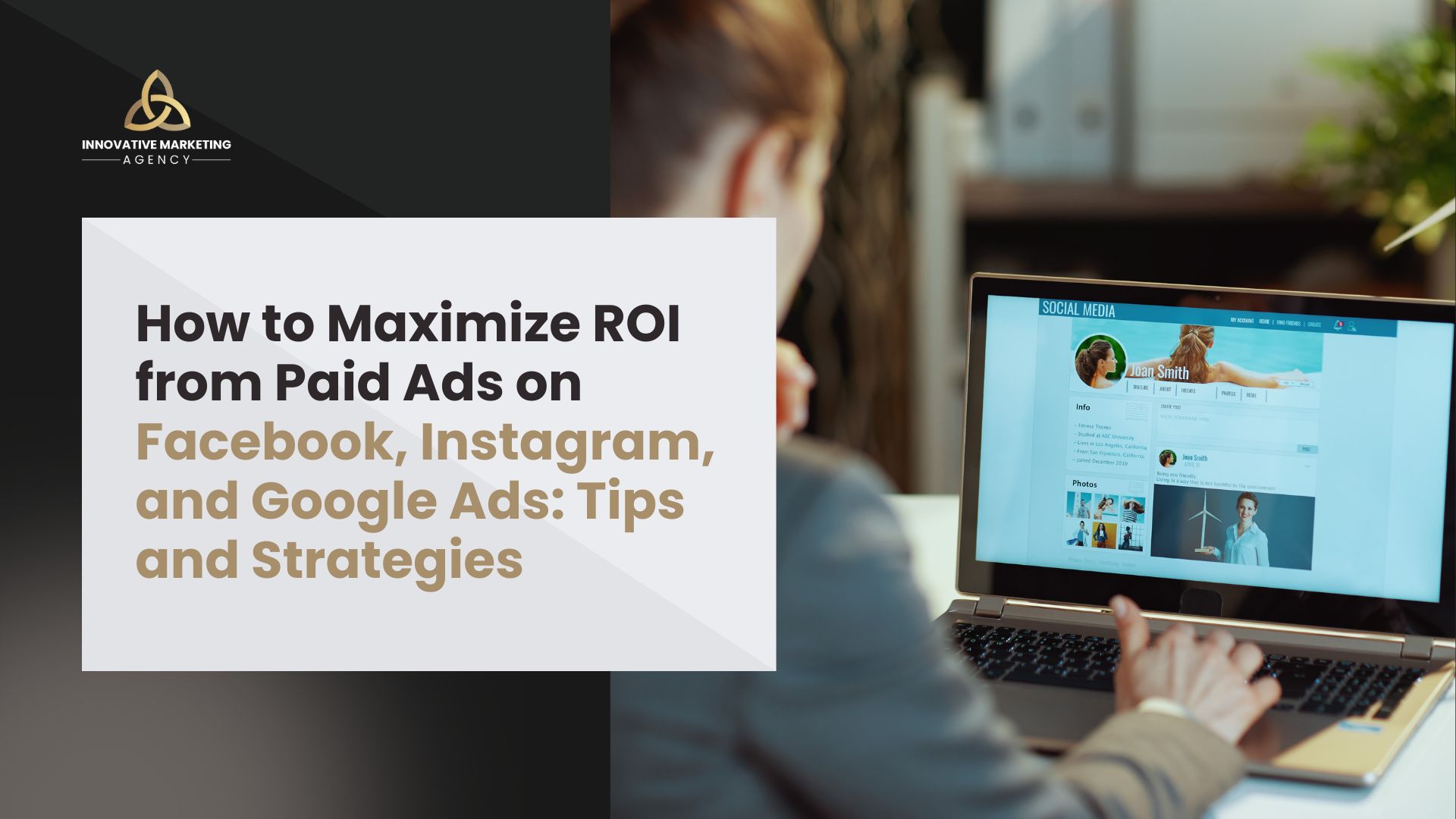
Boost Your Advertising Success: Proven Tips to Maximize ROI
In today's competitive digital landscape, maximizing the return on investment (ROI) from paid advertising campaigns on platforms like Facebook, Instagram, and Google Ads is more crucial than ever. With businesses constantly vying for consumer attention, it's imperative to ensure that every dollar spent on advertising generates significant returns. This blog post aims to provide you with actionable tips and strategies to optimize your paid ad campaigns on these platforms. By implementing these strategies, you can improve ad performance, reduce costs, and achieve higher ROI, ultimately driving business growth and success.
Understanding the nuances of different advertising platforms and how to leverage their unique features can make a substantial difference in your campaign outcomes. Whether you're a small business owner, a digital marketer, or a seasoned advertising professional, the insights shared here will help you navigate the complexities of paid advertising. From setting clear objectives to refining audience targeting, crafting compelling ad copy, and optimizing landing pages, we will cover all essential aspects of paid ad optimization.
As you read through this post, you'll discover the importance of continuous monitoring and real-time adjustments, ensuring that your campaigns remain effective and responsive to changing market conditions. We'll also delve into advanced strategies like A/B testing, dynamic targeting, and leveraging analytics tools to gain deeper insights into your ad performance. By the end of this guide, you'll be equipped with the knowledge and tools needed to maximize your advertising ROI and stay ahead of the competition.
So, let's dive in and explore how you can transform your paid ad campaigns on Facebook, Instagram, and Google Ads into powerful engines of growth and profitability.
Why ROI Matters in Paid Advertising: Understanding the Basics
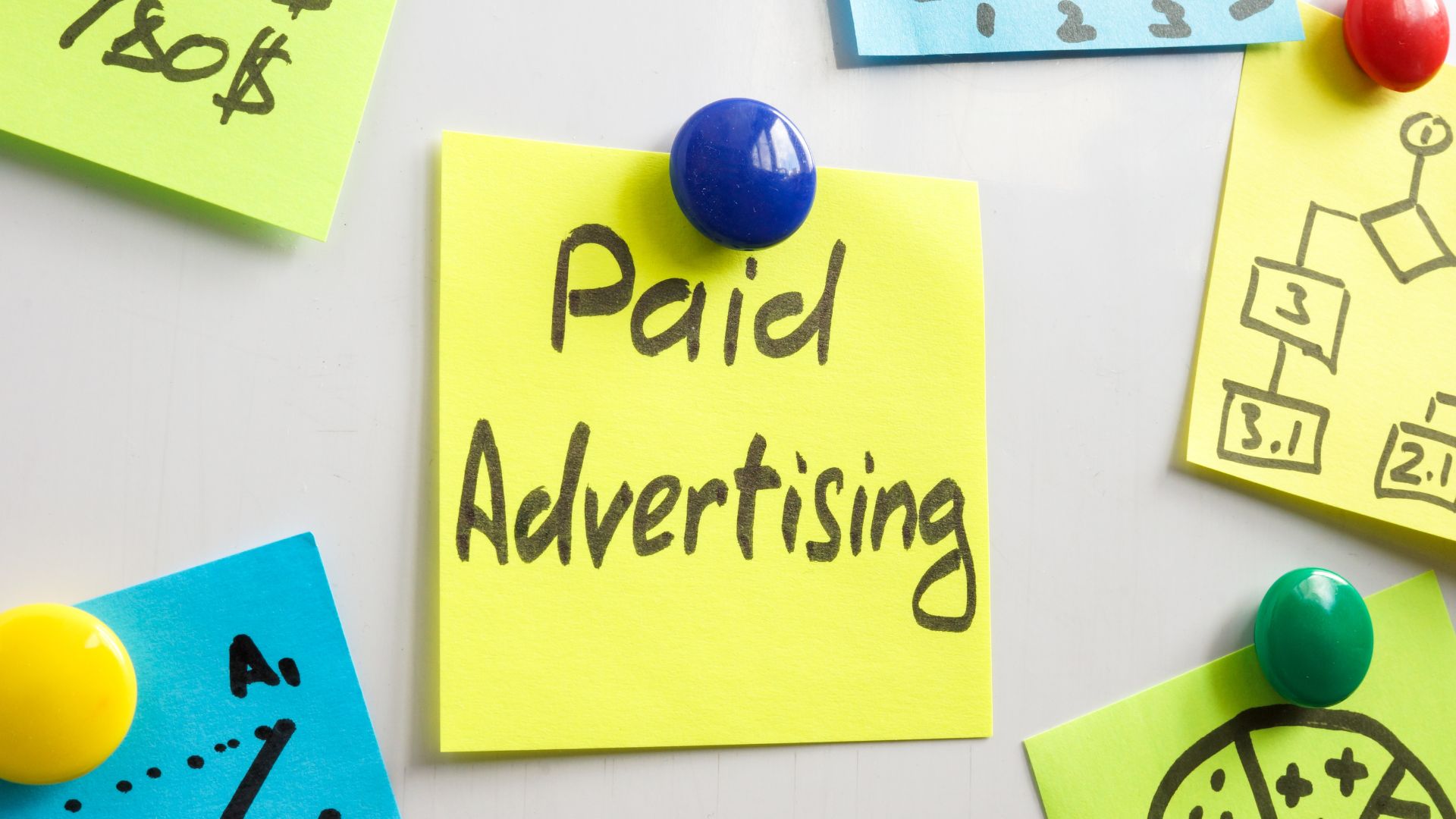
ROI, or Return on Investment, is a critical metric in paid advertising that measures the profitability of your ad campaigns. It represents the financial return you receive from your advertising spend relative to the amount invested. Understanding and optimizing ROI is essential for ensuring that your advertising efforts on platforms like Facebook, Instagram, and Google Ads are cost-effective and contribute to your business's bottom line.
The Key to Effective Ad Spend
ROI is the ultimate measure of your advertising success. It answers the fundamental question: Are your ads generating more revenue than they cost? A positive ROI indicates that your ads are profitable, while a negative ROI suggests that you are losing money on your advertising efforts. By focusing on ROI, you can make informed decisions about where to allocate your budget, which campaigns to scale, and which ones to discontinue.
Calculating ROI Made Simple
Calculating ROI for your ad campaigns involves a straightforward formula:
ROI=(Revenue from Ads−Cost of Ads)Cost of Ads×100\text{ROI} = \frac{(\text{Revenue from Ads} - \text{Cost of Ads})}{\text{Cost of Ads}} \times 100ROI=Cost of Ads(Revenue from Ads−Cost of Ads)×100
For example, if you spend $1,000 on a campaign and generate $3,000 in revenue, your ROI would be:
\text{ROI} = \frac{($3,000 - $1,000)}{$1,000} \times 100 = 200\%
This calculation shows that for every dollar spent, you gained two dollars in profit.
Importance of Measuring ROI
Regularly measuring and analyzing ROI helps you understand the effectiveness of your ad campaigns. It enables you to identify high-performing ads and allocate more budget to them while reducing or discontinuing underperforming ones. This data-driven approach ensures that your advertising spend is always optimized for maximum returns.
Benefits of Tracking ROI
Budget Optimization: By knowing which campaigns yield the highest ROI, you can allocate your budget more efficiently, investing in strategies that drive the most significant returns.
Performance Insights: Tracking ROI provides valuable insights into what works and what doesn't, allowing you to refine your ad strategies for better performance.
Competitive Advantage: A strong ROI indicates a well-optimized campaign, giving you an edge over competitors who may not be utilizing their advertising budget as effectively.
Sustainable Growth: Consistently achieving a positive ROI ensures that your ad campaigns contribute to long-term business growth and sustainability.
Understanding the basics of ROI and its significance in paid advertising sets the foundation for developing effective ad strategies that maximize returns. In the following sections, we will delve deeper into specific tactics and techniques to enhance your ROI across various advertising platforms.
Set Clear, Achievable Goals: The Foundation of Successful Ad Campaigns
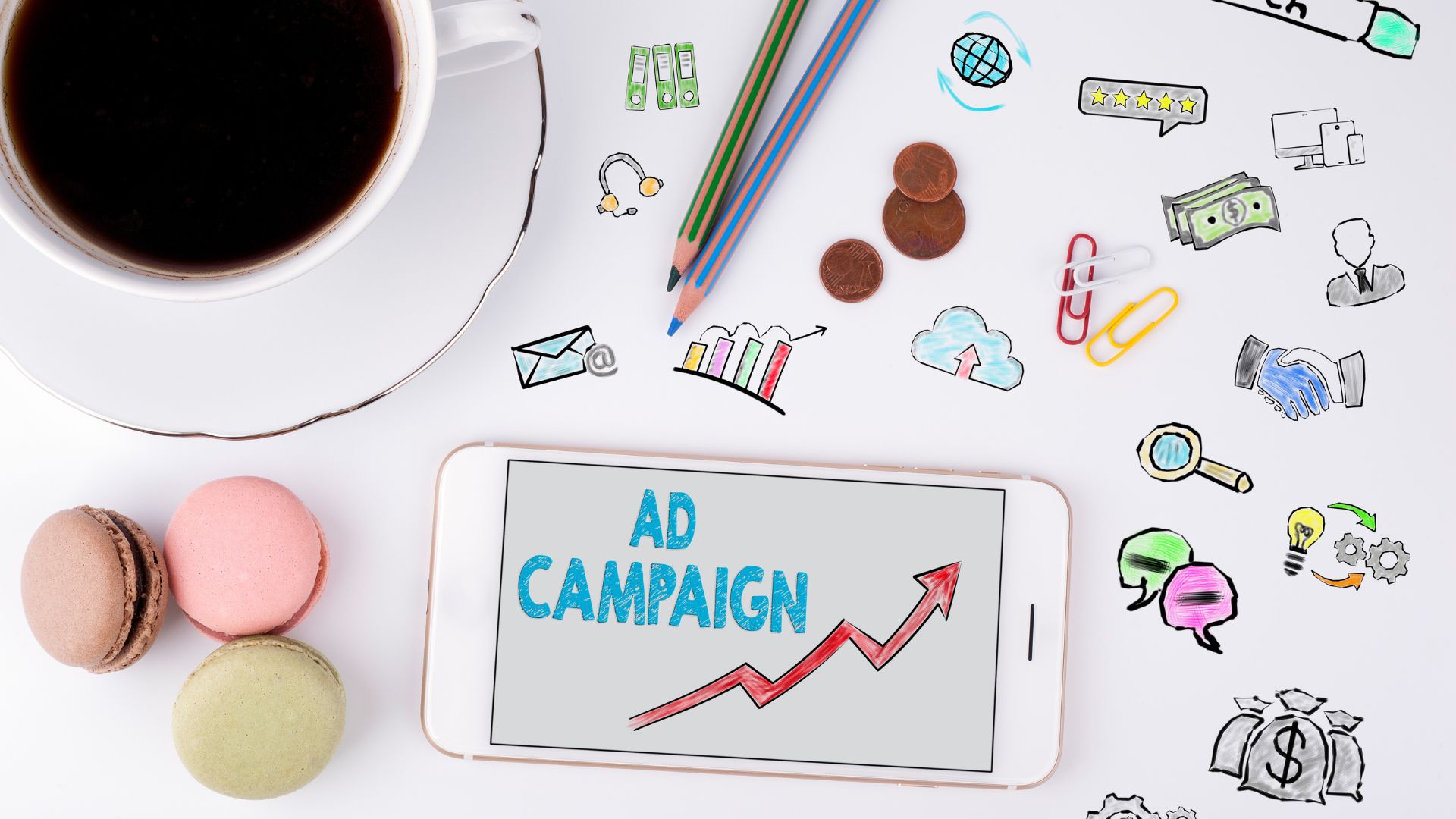
Setting clear, achievable goals is the cornerstone of any successful ad campaign on Facebook, Instagram, and Google Ads. Goals provide direction and purpose, ensuring that every action taken contributes to the desired outcome. Without well-defined goals, ad campaigns can become aimless and inefficient, leading to wasted budget and missed opportunities.
Align Your Ads with Business Objectives
The first step in setting effective goals is to align them with your overall business objectives. Whether your aim is to increase brand awareness, drive website traffic, generate leads, or boost sales, your ad campaigns should support these broader business goals. For example, if your business objective is to increase online sales, your ad campaign goal might be to drive more traffic to your e-commerce site and convert visitors into customers.
SMART Goals for Advertisers
A useful framework for setting effective goals is the SMART criteria, which stands for Specific, Measurable, Achievable, Relevant, and Time-bound. Let's break down each component with examples relevant to ad campaigns:
Specific: Clearly define what you want to achieve. For instance, instead of a vague goal like "increase website traffic," aim for "increase website traffic by 20% in three months."
Measurable: Ensure that your goal can be quantified and tracked. Use metrics such as click-through rates (CTR), conversion rates, and cost per acquisition (CPA) to measure progress.
Achievable: Set realistic goals that are within your capacity to achieve. Consider your current resources, budget, and market conditions.
Relevant: Your goals should align with your overall business strategy and objectives. For example, if your primary focus is customer acquisition, set goals that directly contribute to acquiring new customers.
Time-bound: Establish a clear timeline for achieving your goals. Setting deadlines creates a sense of urgency and helps prioritize tasks. For example, "increase email sign-ups by 15% within the next quarter."
Example Goals
Here are some examples of clear, actionable goals for ad campaigns:
Increase Website Traffic: "Increase website traffic by 25% over the next six months by leveraging Google Ads and Facebook Ads."
Boost Sales: "Achieve a 15% increase in online sales within the next quarter through targeted Instagram ad campaigns."
Generate Leads: "Generate 500 new leads in the next three months using LinkedIn Sponsored Content and Google Search Ads."
Enhance Brand Awareness: "Increase brand awareness by reaching 50,000 unique users with video ads on YouTube within the next two months."
Tracking and Adjusting Goals
Once your goals are set, it's essential to track progress regularly and adjust strategies as needed. Use analytics tools like Google Analytics, Facebook Insights, and Instagram Analytics to monitor key metrics and assess whether you're on track to meet your goals. If you notice that certain campaigns are underperforming, analyze the data to identify potential issues and make necessary adjustments. This might involve tweaking ad copy, refining targeting, or reallocating budget to more effective campaigns.
Tracking and Adjusting Goals
Focus and Direction: Clear goals provide a roadmap for your ad campaigns, ensuring that every action taken contributes to the desired outcome.
Motivation and Accountability: Having specific goals motivates your team and creates accountability, as everyone understands what needs to be achieved and by when.
Performance Measurement: Well-defined goals make it easier to measure performance and evaluate the success of your campaigns.
Continuous Improvement: Regularly tracking progress against your goals allows you to identify areas for improvement and optimize your strategies for better results.
Setting clear, achievable goals is fundamental to the success of your ad campaigns on Facebook, Instagram, and Google Ads. By aligning your goals with business objectives and using the SMART criteria, you can create focused, effective campaigns that drive significant ROI.
Target the Right Audience: The Secret to High Conversion Rates

Targeting the right audience is essential for maximizing the effectiveness of your paid ad campaigns on Facebook, Instagram, and Google Ads. When you reach the right people with your ads, you're more likely to generate interest, engagement, and conversions. Understanding your audience and leveraging advanced targeting options can significantly improve your ad performance and ROI.
Mastering Audience Segmentation
Audience segmentation involves dividing your broader audience into smaller, more specific groups based on shared characteristics. This allows you to tailor your ads to the unique needs and preferences of each segment, increasing the relevance and effectiveness of your campaigns. Key factors to consider for segmentation include demographics, psychographics, behavior, and location.
Demographics: Segment your audience based on age, gender, income, education, and occupation. For example, a luxury brand might target higher-income individuals aged 30-50.
Psychographics: Consider the values, interests, lifestyles, and attitudes of your audience. This helps create ads that resonate on a deeper emotional level.
Behavior: Analyze past behavior such as purchase history, website interactions, and engagement with previous ads. Targeting users based on their behavior can lead to higher conversion rates.
Location: Geographical targeting allows you to reach people in specific locations, whether it's a city, region, or country. This is particularly useful for local businesses or campaigns with regional relevance.
Creating Detailed Buyer Personas
Buyer personas are fictional representations of your ideal customers, based on real data and insights. They help you understand your audience better and tailor your marketing efforts to meet their specific needs. To create effective buyer personas, gather information through surveys.
Craft Compelling Ad Copy and Creatives: Captivate and Convert
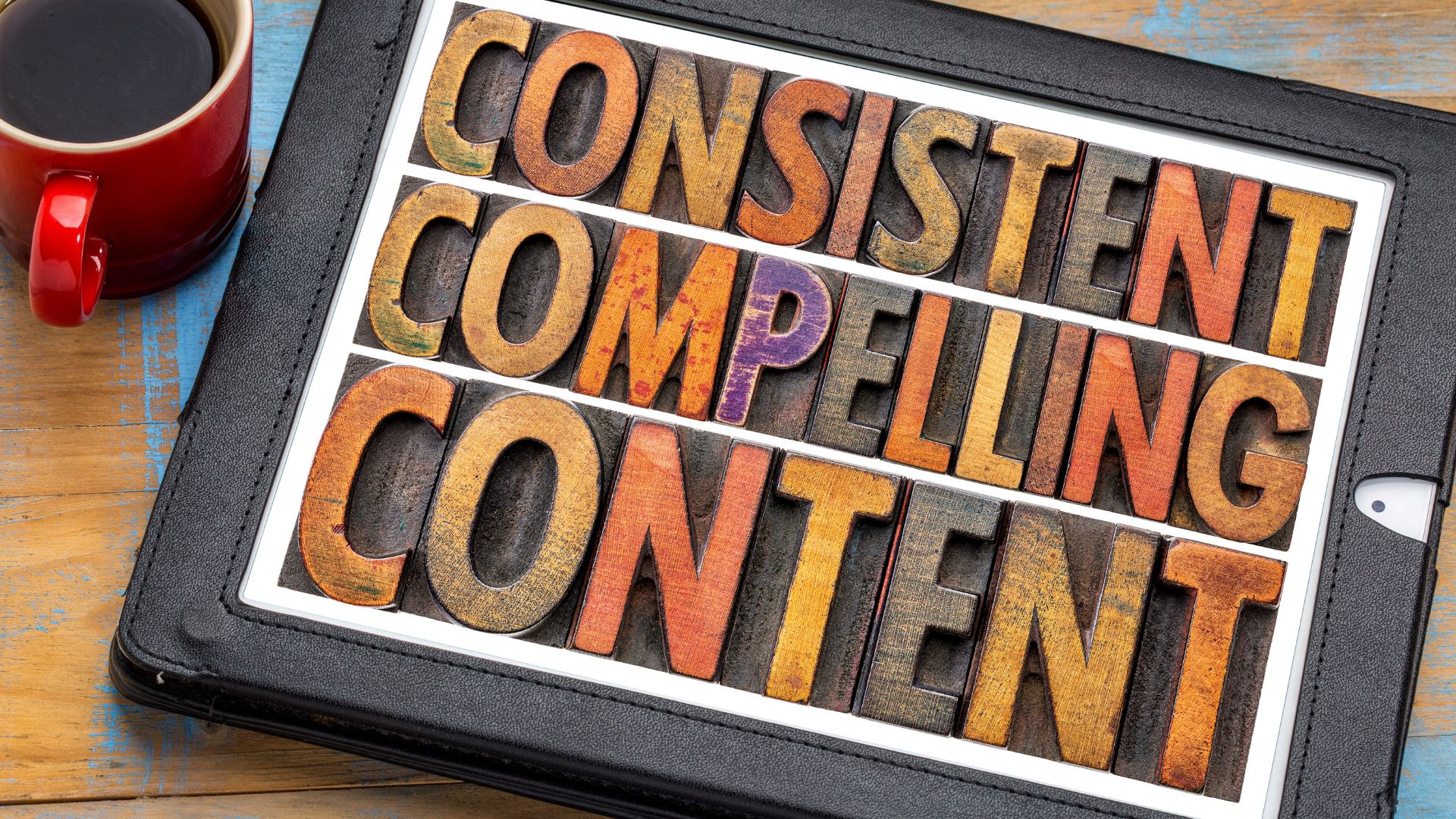
Creating compelling ad copy and visuals is crucial for capturing the attention of your audience and driving conversions. Here’s how you can optimize your ad copy and creatives for maximum impact.
Write Copy That Converts
Effective ad copy is the cornerstone of any successful advertising campaign. To craft copy that converts, follow these key principles:
Strong Call to Actions (CTAs): Your CTA should be clear, concise, and compelling. It should tell the audience exactly what you want them to do next. Phrases like "Shop Now," "Learn More," or "Get Started" can be powerful drivers of action. Ensure your CTA stands out by using contrasting colors and placing it prominently within your ad.
Highlight Benefits, Not Just Features: Focus on how your product or service benefits the user rather than just listing features. Explain how it solves a problem or improves their life. For instance, instead of saying "Our app has a calorie counter," you could say "Track your meals effortlessly and stay on top of your health goals."
Use Persuasive Language: Words that evoke emotions and urgency can significantly increase engagement. Phrases like "Limited Time Offer," "Exclusive Deal," or "Don't Miss Out" create a sense of urgency and prompt immediate action.
Keep it Simple and Clear: Avoid jargon and complex language. Your message should be easy to understand at a glance. People scroll quickly, so your copy needs to convey its message instantly.
Personalization: Tailor your ad copy to the specific audience you are targeting. Use language and references that resonate with their experiences and needs. Personalized ads are more likely to capture attention and drive engagement.
Visual Appeal Matters
The visual components of your ads are just as important as the copy. High-quality visuals can make your ads stand out and convey your message more effectively.
Use High-Quality Images: Grainy or pixelated images can make your brand appear unprofessional. Invest in high-quality photography that represents your brand well. Ensure the images are relevant to the ad content and resonate with your target audience.
Engaging Videos: Video content is incredibly effective for capturing attention. Create short, engaging videos that highlight your product's benefits or tell a compelling story. Videos can convey a lot of information quickly and are often more engaging than static images.
Consistency in Branding: Ensure that your visuals are consistent with your brand's colors, fonts, and overall style. Consistent branding helps in building brand recognition and trust.
Use Eye-Catching Graphics: Incorporate graphics and design elements that draw the eye and emphasize important parts of your ad, like your CTA or key benefits. Infographics and animated graphics can also be effective.
Test Different Visual Formats: Experiment with various formats such as carousel ads, slideshows, and stories. Different formats can engage users in different ways and increase the likelihood of interaction.
The Power of A/B Testing
A/B testing, or split testing, is a method of comparing two versions of an ad to see which one performs better. This technique can help you refine your ad elements and maximize effectiveness.
Test One Variable at a Time: To understand what works and what doesn’t, change only one element at a time, such as the headline, image, or CTA. This way, you can pinpoint exactly which change made a difference.
Track Key Metrics: Monitor performance metrics such as click-through rates (CTR), conversion rates, and engagement rates. Use these metrics to determine which version of the ad is more effective.
Run Tests Simultaneously: Conduct your tests at the same time to ensure that external factors, like time of day or day of the week, do not affect the results.
Use Adequate Sample Sizes: Ensure that you have a large enough sample size to get statistically significant results. Running tests with too small a sample can lead to inaccurate conclusions.
Iterate and Optimize: Use the insights gained from A/B testing to continually refine and improve your ads. Keep testing new variations to stay ahead of trends and maintain high performance.
By focusing on crafting compelling ad copy, using high-quality visuals, and leveraging the power of A/B testing, you can create ads that captivate your audience and drive significant conversions on Facebook, Instagram, and Google Ads. These strategies will help you optimize your ad campaigns and achieve better ROI.
Optimize Your Landing Pages: Ensure a Seamless User Experience

Optimizing your landing pages is crucial for maximizing conversions from your paid ad campaigns on Facebook, Instagram, and Google Ads. A well-optimized landing page provides a seamless user experience that aligns with the ad’s message and encourages visitors to take the desired action. Here’s how to ensure your landing pages are optimized for the best results.
Consistency Is Key
Ensuring that your landing page matches the ad’s message is vital for maintaining a cohesive experience and building trust with your audience.
Align with Ad Messaging: Your landing page should reflect the same message, tone, and offer presented in your ad. This consistency reassures visitors that they have landed in the right place and that the promise made in the ad will be fulfilled. For instance, if your ad promotes a 20% discount, the landing page should prominently display this offer.
Visual Consistency: Use the same colors, fonts, and imagery on your landing page as you do in your ads. This visual harmony creates a seamless transition from ad to landing page, making visitors feel comfortable and more likely to convert.
Clear and Compelling Headline: The headline on your landing page should echo the headline of your ad. It should be clear, compelling, and immediately convey the value of your offer. This alignment helps capture the visitor’s attention and sets the stage for the rest of the page.
User-Friendly Design
A user-friendly design is essential for keeping visitors on your landing page and guiding them towards conversion. Here are some key elements to consider:
Fast Load Times: Slow loading pages can significantly impact your conversion rates. Studies have shown that even a one-second delay in page load time can reduce conversions by 7%. Use tools like Google PageSpeed Insights to test and improve your page load times.
Mobile Optimization: With a significant amount of web traffic coming from mobile devices, it’s crucial that your landing page is fully optimized for mobile users. Ensure that your page is responsive, with elements that resize and rearrange seamlessly on different screen sizes.
Easy Navigation: Simplify navigation by minimizing distractions and focusing on the essential elements that drive conversions. This includes having a clear and prominent CTA, minimalistic design, and easy-to-read content. Avoid clutter and ensure that the path to conversion is straightforward.
Conversion Rate Optimization Techniques
Implementing practical conversion rate optimization (CRO) techniques can help increase the effectiveness of your landing page. Here are some tips:
Compelling CTAs: Your call-to-action should be highly visible and persuasive. Use action-oriented language that tells visitors exactly what to do, such as “Download Now,” “Get Your Free Trial,” or “Sign Up Today.” Ensure that your CTA stands out with a contrasting color and is placed above the fold.
Social Proof: Incorporate testimonials, reviews, and trust badges to build credibility and reduce visitor hesitation. Seeing that others have had positive experiences can significantly boost your conversion rates.
A/B Testing: Continuously test different elements of your landing page to determine what works best. This includes headlines, images, CTAs, and overall layout. Use A/B testing tools like Optimizely or VWO to run experiments and gather data-driven insights.
Minimize Form Fields: If your landing page includes a form, keep it as short as possible. Ask only for essential information to reduce friction and increase the likelihood of completion. Studies show that reducing the number of form fields can improve conversion rates by as much as 120% .
Use High-Quality Visuals: High-quality images and videos can make your landing page more engaging and persuasive. Ensure that your visuals are relevant to your offer and enhance the overall message.
Clear Value Proposition: Clearly articulate the benefits of your offer. Visitors should immediately understand what they will gain by taking the desired action. Use bullet points, bold text, and concise language to highlight key benefits.
By focusing on consistency, user-friendly design, and conversion rate optimization techniques, you can create landing pages that not only attract but also convert visitors effectively. These strategies will help ensure a seamless user experience, ultimately leading to higher conversion rates and better ROI from your paid ad campaigns on Facebook, Instagram, and Google Ads.
Smart Budget Allocation: Get the Most Out of Your Ad Spend

Effectively managing your ad budget is crucial for maximizing ROI from your campaigns on Facebook, Instagram, and Google Ads. Here are strategies for efficient budget management, selecting the right bidding strategies, and dynamically adjusting your budget based on performance data.
Efficient Budget Management
Allocating your budget effectively across different campaigns ensures that you get the most value from your ad spend. Here are some strategies to consider:
Prioritize High-Performing Campaigns: Analyze the performance data from your existing campaigns to identify which ones are delivering the best results. Allocate more budget to these high-performing campaigns to maximize ROI. Tools like Google Analytics and Facebook Ads Manager can help you track and compare performance metrics such as CTR, conversion rates, and cost per conversion.
Test and Learn: Allocate a portion of your budget to testing new campaigns, ad formats, and targeting options. This approach allows you to discover new opportunities and optimize your ad spend based on what works best. Regularly reviewing the performance of these tests can help you refine your strategy and improve overall efficiency.
Use Campaign Budget Optimization (CBO): Platforms like Facebook offer CBO, which automatically distributes your budget across ad sets to get the best results. This feature can help you optimize budget allocation without constant manual adjustments.
Set Clear Objectives: Define specific goals for each campaign, such as brand awareness, lead generation, or sales. Allocate your budget based on these objectives, ensuring that you invest appropriately in campaigns that align with your business goals.
Monitor Spend and Adjust Regularly: Regularly review your budget allocation to ensure it aligns with your performance goals. Use real-time data to make informed decisions about where to allocate your budget for maximum impact.
Choosing the Right Bidding Strategy
Choosing the right bidding strategy is essential for optimizing your ad spend and achieving your campaign objectives. Here are some common bidding strategies and when to use them:
Manual CPC (Cost-Per-Click): This strategy allows you to set a maximum cost you are willing to pay for each click on your ad. It provides control over your budget but requires constant monitoring and adjustments to remain competitive. Use this strategy if you have specific insights into your target audience and know how much you are willing to pay for clicks.
Automated Bidding: Automated bidding strategies, such as Target CPA (Cost-Per-Acquisition), Target ROAS (Return on Ad Spend), and Maximize Conversions, use machine learning to optimize bids for you. These strategies can save time and often deliver better results by adjusting bids in real-time based on performance data. Use automated bidding if you want to leverage data-driven optimization without manual intervention.
Enhanced CPC (ECPC): This strategy adjusts your manual bids to help you get more conversions. It increases bids for clicks that seem more likely to lead to a conversion and lowers bids for less likely clicks. Use ECPC if you want to maintain some control over your bids while taking advantage of automated adjustments.
Maximize Clicks: This automated strategy aims to get as many clicks as possible within your budget. It’s useful for campaigns focused on driving traffic to your website. Use this strategy if your primary goal is to increase website visits rather than immediate conversions.
Target Impression Share: This strategy ensures your ads appear in a certain percentage of eligible impressions, based on your chosen placement (e.g., top of the page, absolute top of the page). Use this strategy if your goal is to increase brand visibility and awareness.
Adjusting Budgets Based on Performance
Dynamic budget adjustments based on performance data are essential for optimizing your ad spend. Here’s how to approach it:
Regular Performance Reviews: Schedule regular reviews of your campaign performance data. Look at key metrics such as CTR, conversion rates, and ROAS to determine which campaigns are delivering the best results.
Reallocate Budget to High Performers: Shift budget from underperforming campaigns to those that are exceeding expectations. This ensures that your budget is always being used where it can generate the highest ROI.
Pause or Adjust Underperforming Campaigns: If a campaign consistently underperforms, consider pausing it or adjusting elements like targeting, ad copy, and visuals. Use A/B testing to identify changes that could improve performance.
Set Automated Rules: Use automated rules in platforms like Facebook Ads Manager and Google Ads to adjust budgets based on specific performance criteria. For example, you can set rules to increase the budget for campaigns with a low CPA or reduce the budget for campaigns with a high CPC.
Monitor Market Trends: Keep an eye on market trends and competitor activities. Changes in the market can impact your campaign performance and budget needs. Adjust your budget allocation to stay competitive and capitalize on new opportunities.
By implementing these strategies, you can manage your ad budget more effectively, choose the right bidding strategies, and make dynamic adjustments based on real-time performance data. This approach will help you get the most out of your ad spend on Facebook, Instagram, and Google Ads, ultimately driving better ROI and business growth.
Monitor and Analyze Performance: Stay Ahead with Data-Driven Insights

Monitoring and analyzing your ad performance is crucial for ensuring that your campaigns on Facebook, Instagram, and Google Ads remain effective and deliver the best possible ROI. By focusing on key metrics, implementing regular reporting, and utilizing the best analytical tools, you can gain valuable insights and make informed decisions to optimize your ad strategies.
Key Metrics to Watch
Identifying and tracking the right metrics is essential for evaluating the success of your ad campaigns. Here are some of the most important metrics to monitor:
Click-Through Rate (CTR): CTR measures the number of clicks your ad receives divided by the number of times it is shown (impressions). A high CTR indicates that your ad is relevant and engaging to your audience. Monitor CTR to assess the effectiveness of your ad copy and visuals.
Cost Per Click (CPC): CPC is the amount you pay for each click on your ad. Lowering CPC while maintaining or increasing CTR can improve the cost-efficiency of your campaigns. Track CPC to manage your ad budget effectively.
Conversion Rate: This metric shows the percentage of users who complete a desired action (e.g., making a purchase, signing up for a newsletter) after clicking on your ad. A high conversion rate indicates that your landing page and overall user experience are effective. Monitor conversion rates to gauge the success of your ad's call-to-action and landing page.
Return on Ad Spend (ROAS): ROAS measures the revenue generated for every dollar spent on advertising. It’s a direct indicator of the profitability of your campaigns. Aim for a high ROAS to ensure your ad spend is generating a strong return.
Cost Per Acquisition (CPA): CPA tracks how much it costs to acquire a customer through your ad campaign. Lowering CPA while maintaining high conversion rates is key to improving ROI. Monitor CPA to understand the efficiency of your ad spend in acquiring customers.
Impressions and Reach: Impressions refer to the number of times your ad is shown, while reach indicates the number of unique users who see your ad. These metrics help you understand the visibility and exposure of your campaigns.
The Importance of Regular Reporting
Regular reporting is vital for tracking progress, identifying trends, and making informed adjustments to your ad campaigns. Here’s why regular performance reports are essential:
Track Progress: Regular reports help you keep track of your campaigns’ progress towards your goals. By comparing performance over time, you can identify which strategies are working and which need adjustment.
Identify Trends: Performance reports allow you to spot trends and patterns in your data. Understanding these trends can help you anticipate market changes and adjust your strategies accordingly.
Informed Decision-Making: With up-to-date performance data, you can make informed decisions about where to allocate your budget, which campaigns to scale, and which to pause or adjust. Data-driven decisions are more likely to improve your campaign’s effectiveness.
Transparency and Accountability: Regular reports provide transparency and accountability, helping you justify your ad spend to stakeholders and make a case for budget adjustments based on concrete data.
Continuous Improvement: Regular performance reviews foster a culture of continuous improvement. By constantly evaluating and optimizing your campaigns, you can stay ahead of the competition and achieve better results over time.
Best Tools for Analytics
Utilizing the right tools for performance tracking and analysis is crucial for gaining actionable insights. Here are some of the best tools for monitoring your ad campaigns on Facebook, Instagram, and Google Ads:
Google Analytics: Google Analytics is a powerful tool for tracking website traffic, user behavior, and conversion data. It integrates seamlessly with Google Ads, allowing you to monitor the performance of your ad campaigns and gain insights into how users interact with your site. Key features include goal tracking, e-commerce reporting, and audience segmentation.
Facebook Ads Manager: Facebook Ads Manager provides comprehensive analytics for your Facebook and Instagram ad campaigns. It offers detailed metrics on reach, engagement, conversions, and more. The platform also allows you to set up custom reports, track performance over time, and use advanced features like A/B testing and audience insights.
Google Ads: Google Ads itself provides robust reporting tools that offer insights into your ad performance, including metrics like CTR, CPC, conversion rates, and more. The platform’s integration with Google Analytics enhances its capabilities, allowing for deeper analysis and better optimization.
HubSpot: HubSpot’s marketing software includes powerful analytics tools that can track the performance of your ad campaigns across multiple channels. It provides detailed reports on engagement, conversions, and ROI, and integrates with platforms like Google Ads and Facebook Ads for seamless tracking.
SEMrush: SEMrush offers comprehensive analytics and reporting tools for paid search campaigns. It provides insights into keyword performance, competitor analysis, and ad copy effectiveness. SEMrush’s integration with Google Analytics and Google Ads enhances its capabilities, making it a valuable tool for optimizing your campaigns.
By focusing on these key metrics, implementing regular performance reporting, and utilizing the best analytical tools, you can monitor and analyze your ad campaigns effectively. This data-driven approach will help you stay ahead of the competition, optimize your strategies, and achieve better ROI from your paid ad campaigns on Facebook, Instagram, and Google Ads.
Continuous Improvement: The Path to Sustained Ad Success

Continuous improvement is essential for maintaining and enhancing the success of your ad campaigns on Facebook, Instagram, and Google Ads. By making real-time adjustments, learning from past campaigns, and scaling up successful ones, you can ensure sustained growth and higher ROI. Here's how to implement these strategies effectively.
Real-Time Campaign Adjustments
Real-time adjustments based on performance insights are crucial for optimizing your ad campaigns and maximizing ROI. Here's why and how to implement them:
Immediate Response to Data: Real-time adjustments allow you to respond immediately to performance data, ensuring that your campaigns remain effective. If an ad is underperforming, you can quickly tweak elements like ad copy, visuals, or targeting to improve results. Conversely, if an ad is doing exceptionally well, you can increase its budget to capitalize on its success.
Optimize Bidding Strategies: Adjust your bidding strategies in real-time to ensure you are getting the best value for your ad spend. For example, if you notice that certain keywords or audiences are generating higher conversions at lower costs, you can increase your bids for those segments to enhance performance.
Dynamic Budget Allocation: Use real-time data to reallocate your budget towards the best-performing campaigns. This dynamic approach ensures that your ad spend is always directed towards the most profitable areas, maximizing ROI.
Use Automated Rules: Platforms like Facebook Ads Manager and Google Ads offer automated rules that can adjust your campaigns based on predefined criteria. For instance, you can set rules to increase the budget for ads with a low cost per conversion or pause ads with a high cost per click.
Monitor Key Metrics: Keep a close eye on key metrics such as click-through rate (CTR), conversion rate, and return on ad spend (ROAS). Regular monitoring helps you identify trends and make informed decisions quickly.
Learning from Past Campaigns
Analyzing past campaigns provides valuable insights that can help you improve future performance. Here's how to effectively learn from your past efforts:
Post-Campaign Analysis: Conduct a thorough analysis after each campaign to understand what worked and what didn’t. Look at metrics such as CTR, CPC, conversion rates, and overall ROI. Identify which elements contributed to success and which ones need improvement.
Identify Patterns and Trends: Look for patterns and trends in your campaign data. For example, you might find that certain types of ad copy or visuals consistently perform better. Use these insights to inform your future campaigns.
A/B Testing Results: Review the results of any A/B tests you conducted. Identify which variations of your ads performed the best and understand why. Apply these learnings to create more effective ads in the future.
Feedback and Reviews: Gather feedback from your audience and analyze reviews and comments. This qualitative data can provide insights into what your audience likes or dislikes about your ads, helping you refine your approach.
Competitor Analysis: Study the campaigns of your competitors. Analyze their strategies, ad creatives, and performance to identify areas where you can improve or differentiate your own campaigns.
Scaling Up Successful Campaigns
Scaling up successful campaigns can significantly boost your ROI and business growth. Here’s how to scale up effectively:
Increase Budget Gradually: Start by gradually increasing the budget for your top-performing campaigns. This cautious approach allows you to scale up without risking a significant increase in costs. Monitor performance closely to ensure that the increased spend continues to deliver positive results.
Expand Audience Targeting: Once you have identified a successful campaign, consider expanding your audience targeting. Use lookalike audiences on Facebook and Instagram to reach new users who share characteristics with your best-performing audience segments. On Google Ads, broaden your keyword targeting to capture more search traffic.
Replicate Successful Elements: Identify the elements that made your campaign successful, such as specific ad copy, visuals, or offers. Replicate these elements in new campaigns to leverage their proven effectiveness.
Leverage Retargeting: Use retargeting to re-engage users who interacted with your ads but did not convert. Retargeting can significantly increase conversion rates and ROI by reminding potential customers of your offer.
Diversify Ad Placements: Expand your ad placements to reach a broader audience. For example, if a campaign is performing well on Facebook, consider running it on Instagram and Google Display Network as well. Diversifying your placements can help you reach more potential customers and maximize your ad spend.
Monitor and Optimize Continuously: Even as you scale up, continue to monitor and optimize your campaigns. Regularly review performance data and make adjustments to ensure that your campaigns remain effective at a larger scale.
By making real-time adjustments, learning from past campaigns, and scaling up successful ones, you can achieve continuous improvement and sustained success in your ad campaigns. This approach ensures that your efforts on Facebook, Instagram, and Google Ads remain efficient and effective, driving better ROI and business growth.
Final Thoughts: Commit to Ongoing Optimization
As we navigate the ever-evolving landscape of paid advertising, the key to sustained success lies in ongoing optimization and adaptability. The digital marketing world is constantly changing, with new tools, technologies, and trends emerging regularly. To stay ahead and maximize ROI, it’s crucial to continuously refine your strategies and remain flexible in your approach.
The Ever-Evolving Landscape of Paid Ads
The digital advertising space is dynamic, with constant updates to algorithms, platforms, and consumer behavior. For instance, Facebook and Instagram frequently update their ad policies and features, while Google Ads continually refines its algorithms to improve user experience and ad relevance. Staying informed about these changes is essential to keep your campaigns effective.
Stay Informed and Educated: Keep up with the latest trends and updates in digital advertising. Subscribe to industry blogs, attend webinars, and participate in online forums to stay informed about new developments. Platforms like HubSpot, WordStream, and SEMrush regularly publish updates and best practices that can help you stay current.
Adapt to Market Changes: Be prepared to pivot your strategies based on market trends and consumer behavior. For example, the increasing use of mobile devices has made mobile optimization more critical than ever. Similarly, the rise of video content necessitates incorporating more video ads into your campaigns.
Leverage New Tools and Technologies: Embrace new advertising tools and technologies to enhance your campaigns. Advanced analytics tools, AI-driven optimization, and programmatic advertising can provide deeper insights and more effective targeting.
Experiment and Innovate: Don’t be afraid to experiment with new ad formats, creative approaches, and targeting strategies. Testing and innovation are key to discovering what works best for your brand and audience. Regular A/B testing and performance analysis can help you identify successful tactics and areas for improvement.
Take Action Now
The strategies and tips discussed in this guide provide a robust framework for optimizing your paid ad campaigns on Facebook, Instagram, and Google Ads. Implementing these techniques can lead to immediate improvements in your ROI and long-term business growth.
Set Clear Goals and Track Performance: Begin by setting clear, measurable goals for your campaigns. Use tools like Google Analytics and Facebook Ads Manager to track key metrics and assess your progress. Regular performance reviews will help you stay on track and make necessary adjustments.
Optimize Your Ad Creatives and Copy: Ensure your ad copy is compelling and your visuals are high-quality. Use strong CTAs and persuasive language to drive engagement and conversions. Regularly refresh your ad creatives to avoid ad fatigue and keep your audience engaged.
Refine Your Targeting: Use audience segmentation and buyer personas to target the right audience. Leverage advanced targeting options on Facebook, Instagram, and Google Ads to reach users most likely to convert. Regularly review and adjust your targeting based on performance data.
Enhance Your Landing Pages: Optimize your landing pages for a seamless user experience. Ensure consistency with your ad messaging, fast load times, and mobile optimization. Use conversion rate optimization techniques to increase the effectiveness of your landing pages.
Monitor and Adjust in Real-Time: Make real-time adjustments to your campaigns based on performance insights. Use automated rules and dynamic budget allocation to optimize your ad spend. Continuously monitor key metrics and refine your strategies to stay competitive.
By committing to ongoing optimization and staying adaptable, you can navigate the complexities of paid advertising and achieve sustained success. Take action now to implement these strategies, and you’ll see significant improvements in your ad performance and ROI. Remember, the digital marketing landscape is ever-changing, and staying proactive and informed is the key to staying ahead.
For a free consultation, book a discovery call with Innovative Marketing Agency today. Let’s take your advertising efforts to the next level!
Join The
Innovative Marketing Pro
15 Days FREE Trial!

You Pay $0 Today
You Won't be charged until Free Trial Ends
No Commitment, Cancel Anytime
As a reminder we will email you 7 days before Trial Ends
Recent Posts
Understanding the Customer Value Journey: A Complete Guide
How to Maximize ROI from Paid Ads on Facebook, Instagram, and Google Ads: Tips and Strateg
Crafting High-Impact Content Marketing Strategies
10 Direct Response Copywriting Tips to Boost Conversions
Maximizing Conversions: The Best Funnel Builders Reviewed
Building Strong Online Communities: Best Platforms and Practices"
Boost Your Lead Quality: 10 AI-Powered Lead Generation Strategies
OPTIMIZE YOUR PAID AD CAMPAIGNS WITH OUR COMPREHENSIVE CHECKLIST!
Don't let poor-performing ads drain your budget. Download our Paid Traffic Assessment Checklist now and start optimizing your Facebook, Instagram, and Google Ads campaigns. Improve your ad performance, increase engagement, and achieve better ROI with actionable insights and proven strategies.
Join The
Innovative Marketing Pro
15 Days FREE Trial!

You Pay $0 Today
You Won't be charged until Free Trial Ends
No Commitment, Cancel Anytime
As a reminder we will email you 7 days before Trial Ends
Recent Posts
Understanding the Customer Value Journey: A Complete Guide
How to Maximize ROI from Paid Ads on Facebook, Instagram, and Google Ads: Tips and Strategies
Crafting High-Impact Content Marketing Strategies
10 Direct Response Copywriting Tips to Boost Conversions
Maximizing Conversions: The Best Funnel Builders Reviewed
Building Strong Online Communities: Best Platforms and Practices"
Boost Your Lead Quality: 10 AI-Powered Lead Generation Strategies
IM Agency Services
Marketing Research
Paid Advertising
Direct Response Copywriting
Funnels and Automations
Marketing Automation
Business Development
IM Pro Features
Lead Generation Automation
Sales Funnels
Customer Relationship Management
Courses Builder
Affiliate Builder
Invoicing
Team Scheduling
Email Automations
Pipelines and workflow
And Way More....
Address & Phone




Innovative Marketing Agency
We Design, Build, & Optimize Campaigns
Copyright © 2025 Innovative Marketing Agency LLC










